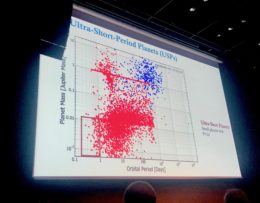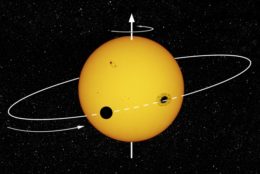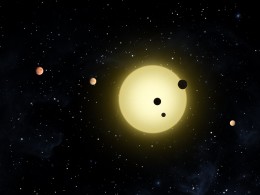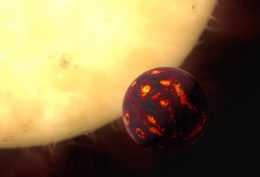Editor’s note: This week we’re in Reykjavik, Iceland at the Extreme Solar Systems (ExSS) IV meeting. Follow along to catch some of the latest news from the field of exoplanet research!
Session 5: Dynamical Evolution
After yesterday’s observational talks, Day 2 kicked off with some theory. The morning’s discussions centered on how the dynamics of planetary systems evolve and shape the system over time.

Planet mass vs. orbital period for observed exoplanets. The red box in the lower left identifies the population of ultra-short-period planets. [Dong Lai/exoplanets.org]
Rosemary Mardling (Monash) presented her new formulation that describes two-planet systems that are near resonance, i.e., they exert a regular, periodic gravitational influence on each other that nudges their periods toward an integer multiple of each other.
Where can we find hidden companions in multi-planet systems? Smadar Naoz (UCLA) showed how, if we know the configuration of the inner planets of a multi-planet system (i.e., how far they are from each other, their eccentricities, etc.), then we can estimate the location of an external, wide-orbit companion planet by calculating how the planets are likely to interact.
Kassandra Anderson (Cornell) presented work exploring the dynamical histories of warm Jupiters, giant planets with orbital periods of 10–300 days. Her calculations explore different ways of forming these planets, from violent collisions in-situ to migration through a disk.Many inner giant planets are found on eccentric orbits. How do these planets gain their high eccentricities? And why do the highest-eccentricity planets tend to also be the highest-mass ones? Renata Frelikh (UC Santa Cruz) argued that this can be explained by a system undergoing a giant-impact phase, in which impacts between large planets lead to collisional growth and skewed orbits.
Jacques Laskar (Obs Paris) rounded out the session by discussing a new framework for rapidly understanding the dynamics of a planetary system. His work relies on a description of angular momentum, and it makes it possible to tell, upon discovering a new planetary system, whether the system is stable or unstable.
Session 6: Ultrashort Periods and Planet–Star Interactions
Having an ultra-short period presents an occupational hazard: these planets are likely to be strongly influenced by interactions with their host star. Today’s mid-morning session highlighted a number of interesting research topics related to these extreme planets and their environments.
Ray Jayawardhana (Cornell) introduced us to two radical worlds: Kelt-9b, the hottest gas giant known at more than 4,000 K; and 55 Cancri e, a highly irradiated terrestrial planet on an blazing 18-hour orbit that has surprisingly managed to hold on to its atmosphere. Jayawardhana and his research group have used high-resolution spectroscopy to probe the composition of the atmospheres of these extreme worlds.
Radio astronomy is rarely associated with exoplanet research, but magnetized planets are expected to emit strongly at radio wavelengths. Spotting this emission is tough, but Joseph Callingham (ASTRON) presented recent observations from the LOFAR array of low-frequency radio emission associated with an M dwarf. Follow-up observations confirm the presence of a close-in exoplanet in the system. Could this be the launch of exoplanet radio astronomy?
WASP-12b is a well-studied hot Jupiter that provides us with a prime opportunity to explore star-planet interactions. Two presentations focused on aspects of this extreme system:
- Josh Winn (Princeton) reported on transit timing observations of WASP-12 that show tidal decay — decay of the planet’s orbit due to interactions with its host — occurring in real-time on observable timescales.
- Taylor Bell (McGill) discussed the hunt to understand WASP-12b’s unusual, double-peaked infrared phase curve — the planet brightens twice per day, rather than the expected one time. He concluded that this can be explained by WASP-12b losing mass in the form of a hot stream of gas flowing from the planet to its host star.
Many recently discovered short-period super-Earths and sub-Neptune planets have large tilts between their spin axes and their orbital axes. Sarah Millholland (Yale) argued that these high-obliquity states can drive higher levels of tidal dissipation, dumping heat into the planet interiors and ultimately inflating their atmospheres to larger radii.

Ben Montet reviews the evolution of open questions about hot Jupiters since 1996. [AAS Nova/Ben Montet]
Roughly 40% of hot-Jupiter hosts show spectroscopic signatures that suggest we’re seeing these stars through a shroud of circumstellar gas that’s been torn from their irradiated, close-in planets. Carole Haswell (Open U) reported on a planet-hunting strategy that targets stars that don’t have known planets but that show similar signatures in their spectra. So far, the Dispersed Matter Planet Project has succeeded in finding three previously unknown planets using this strategy.
Session 7: Stellar Spins and Obliquities
Why should we care about stellar obliquities, the tilts of stars’ rotation axes relative to their orbital angular momentum? This misalignment can tell us about a planetary system’s formation and evolution.
Simon Albrecht (Aarhus U) kicked off the session with a broad overview of some trends observed in stellar obliquities, such as an apparent link between high stellar obliquity and high close-in planet eccentricity, and a typical alignment between multi-planetary system orbital planes and stellar rotation. These trends indicate that tidal alignment is likely an important factor in shaping obliquity distributions.

Artist’s impression of a system with a spin–orbit misalignment: the planet orbits in a different plane than the star’s rotation. [Ricardo Cardoso Reis (IA/UPorto)]
To understand stars with tilted planetary systems, we may need to look back in time to when these stars were still dispersing their surrounding disks. Cristobal Petrovich (CITA) presented a model in which a short-period planetary system can be excited to high obliquities (often all the way to polar orbits!) by a wide-orbit Jovian companion embedded in a photo-evaporating disk.
The final presentations explored a few example systems and their spin–orbit (mis)alignments:
- HD3167 c is a sub-Neptune on a nearly polar orbit around its star. Shweta Dalal (IAP) presented measurements of this planet and an additional planet in the system, which is shown to be co-planar. The dynamics of the system indicate the planets are unlikely to have arrived on these orbits without help from an unseen outer companion.
- K2-25b is a Neptune-sized planet orbiting a young M-dwarf host star. Previously, only one M-dwarf had a highly precise obliquity measurement — and that system, GJ 436, is highly misaligned. Gudmundur Stefansson (Penn State) presented new, precise obliquity measurements for K2-25b, showing that this system is contrastingly well-aligned.
- Marta Bryan (UC Berkeley) presented on a complex hunt to understand the system 2M0122, a star and its planetary-mass companion. Bryan looked to fully characterize this system by measuring not just the stellar spin and orbital angular momentum vectors, but also the planet’s spin vector. This uniquely complete view of the 3D angular momentum architecture of the system provides insight into the system’s formation history.
Session 8: Transiting Multi-Planet Systems
One of Kepler’s prime outcomes was the discovery that compact, multi-planet systems are common throughout the galaxy. What have we learned from transits of these systems in recent years?
Trevor David (JPL/Flatiron) opened the session by presenting on V1298 Tau, a young solar analog that’s just 20 or 30 million years old. A family of four transiting planets have been recently discovered orbiting within 0.5 AU of the star, providing us with a unique opportunity to study newly born planets at a time when their young host star is still emitting large amounts of harsh, high-energy radiation. This may tell us more about how compact multi-planet systems form.
We’ve noted that giant planets tend to form preferentially around higher-metallicity stars — but what are the trends for smaller planets? Sophie Anderson (MIT) presented results indicating that compact, multi-planet systems preferentially form around metal-poor M dwarfs. This could be explained if giant planets tend to disrupt interior, compact multiple systems.

Artist’s impression of a multi-planet system in which the three currently transiting planets all have different impact parameters. [NASA/Tim Pyle]
Matthias He (Penn State) showed that modeling of the Kepler population of planetary systems reveals a non-random distribution: instead, there seems to be clustering of planet sizes and periods within each system. This is consistent with previous evidence for two populations of planetary systems: a low-mutual-inclination population with low eccentricities, and one with high mutual inclinations or isolated planets.
How do we effectively categorize observed planets, and what can this categorization tell us about yet-unobserved planets? Emily Sandford (Columbia) took us on a unexpected journey through her collaborative work conducted with an expert in computational linguistics. By treating different kinds of planets as different parts of speech, and treating planetary systems as complete sentences, we can use natural language processing techniques to classify planets and predict the next unobserved planet orbiting a star.
The final presentation of the session was given by Joseph Rodriguez (Harvard-Smithsonian CfA) — who opened by graciously crediting Astrobites for his talk title. Rodriguez presented on K2-266, a compact six-planet system in which just one of the planets — an ultra-short-period super-Earth — has a significantly misaligned orbit. How do systems like this form? Rodriguez outlines one possible explanation, in which an additional unseen companion could drive the odd misalignment.





1 Comment
Pingback: Extreme Solar Systems IV | astrobites